fuel filter VOLVO V90 2017 Owners Manual
[x] Cancel search | Manufacturer: VOLVO, Model Year: 2017, Model line: V90, Model: VOLVO V90 2017Pages: 594, PDF Size: 15.07 MB
Page 10 of 594

8
STARTING AND DRIVING
Alcohol lock*
384
Bypass of the alcohol lock *
384
Before starting the engine with the alcohol lock 384
Ignition positions 385
Starting the car 386
Switching off the car 387
Steering lock 388
Using jump starting with another battery 388
Gearbox 389
Gear positions for automatic gearbox 390
Manual gearbox 392
Gear shift indicator *
392
Gear selector inhibitor 394
Changing gear with steering wheel paddles * 395
Start/Stop 396
Using the Start/Stop function 396
Conditions for the Start/Stop function 398
Drive modes *
400
Drive mode ECO 402
Level control * and shock absorption
405
All-wheel drive *
405
Brake functions 406
Foot brake 406
Emergency brake lights408
Brake assistance 408
Auto braking after a collision 408
Parking brake 409
Using the parking brake 410
In the event of a fault in the parking brake 411
Hill start assist 412
Automatic braking when stationary 412
Driving in water 413
Overheating in the engine and drivesystem 414
Overloading the starter battery 415
Preparations for a long trip 415
Winter driving 416
Opening/closing the fuel filler flapand refuelling 417
Handling of fuel 418
Petrol 419
Diesel 420
Empty tank and diesel engine 420
Diesel particulate filter 421
Economical driving 422
Towing bracket *
422
Extendable/retractable towing brackets *
423
Towing bracket specifications *
425
Driving with a trailer 426
Driving with a trailer under special conditions 428
Trailer Stability Assist *
428
Towing eye 430
Towing 431
Recovering the car 432
Page 28 of 594
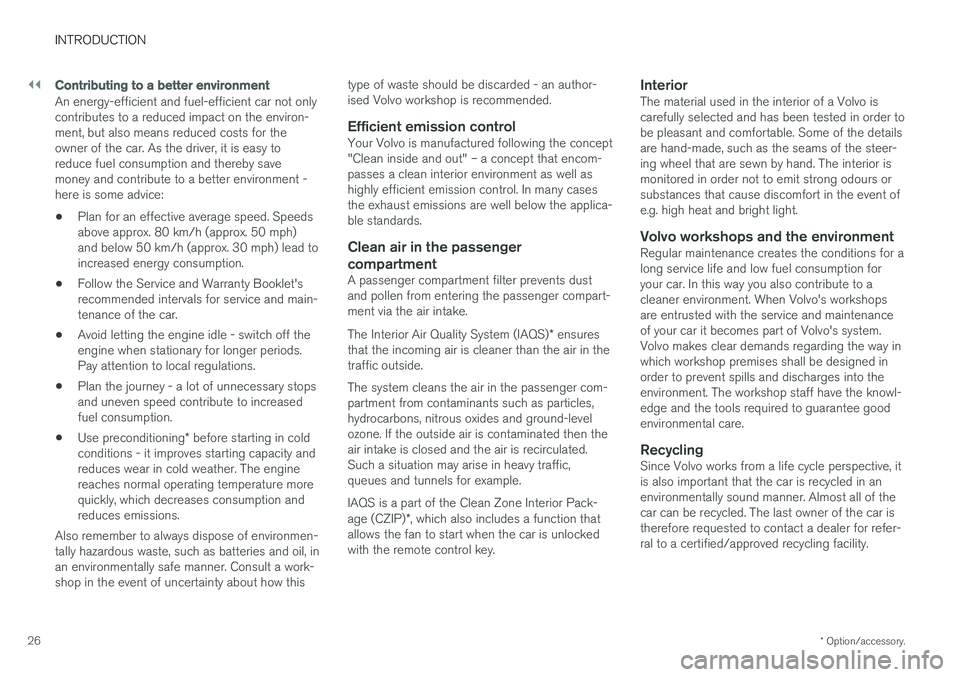
||
INTRODUCTION
* Option/accessory.
26
Contributing to a better environment
An energy-efficient and fuel-efficient car not only contributes to a reduced impact on the environ-ment, but also means reduced costs for theowner of the car. As the driver, it is easy toreduce fuel consumption and thereby savemoney and contribute to a better environment -here is some advice:
• Plan for an effective average speed. Speedsabove approx. 80 km/h (approx. 50 mph)and below 50 km/h (approx. 30 mph) lead toincreased energy consumption.
• Follow the Service and Warranty Booklet'srecommended intervals for service and main-tenance of the car.
• Avoid letting the engine idle - switch off theengine when stationary for longer periods.Pay attention to local regulations.
• Plan the journey - a lot of unnecessary stopsand uneven speed contribute to increasedfuel consumption.
• Use preconditioning
* before starting in cold
conditions - it improves starting capacity andreduces wear in cold weather. The enginereaches normal operating temperature morequickly, which decreases consumption andreduces emissions.
Also remember to always dispose of environmen-tally hazardous waste, such as batteries and oil, inan environmentally safe manner. Consult a work-shop in the event of uncertainty about how this type of waste should be discarded - an author-ised Volvo workshop is recommended.
Efficient emission controlYour Volvo is manufactured following the concept"Clean inside and out" – a concept that encom-passes a clean interior environment as well ashighly efficient emission control. In many casesthe exhaust emissions are well below the applica-ble standards.
Clean air in the passenger
compartment
A passenger compartment filter prevents dustand pollen from entering the passenger compart-ment via the air intake. The Interior Air Quality System (IAQS) * ensures
that the incoming air is cleaner than the air in the traffic outside. The system cleans the air in the passenger com- partment from contaminants such as particles,hydrocarbons, nitrous oxides and ground-levelozone. If the outside air is contaminated then theair intake is closed and the air is recirculated.Such a situation may arise in heavy traffic,queues and tunnels for example. IAQS is a part of the Clean Zone Interior Pack- age (CZIP) *, which also includes a function that
allows the fan to start when the car is unlocked with the remote control key.
InteriorThe material used in the interior of a Volvo iscarefully selected and has been tested in order tobe pleasant and comfortable. Some of the detailsare hand-made, such as the seams of the steer-ing wheel that are sewn by hand. The interior ismonitored in order not to emit strong odours orsubstances that cause discomfort in the event ofe.g. high heat and bright light.
Volvo workshops and the environmentRegular maintenance creates the conditions for along service life and low fuel consumption foryour car. In this way you also contribute to acleaner environment. When Volvo's workshopsare entrusted with the service and maintenanceof your car it becomes part of Volvo's system.Volvo makes clear demands regarding the way inwhich workshop premises shall be designed inorder to prevent spills and discharges into theenvironment. The workshop staff have the knowl-edge and the tools required to guarantee goodenvironmental care.
RecyclingSince Volvo works from a life cycle perspective, itis also important that the car is recycled in anenvironmentally sound manner. Almost all of thecar can be recycled. The last owner of the car istherefore requested to contact a dealer for refer-ral to a certified/approved recycling facility.
Page 422 of 594
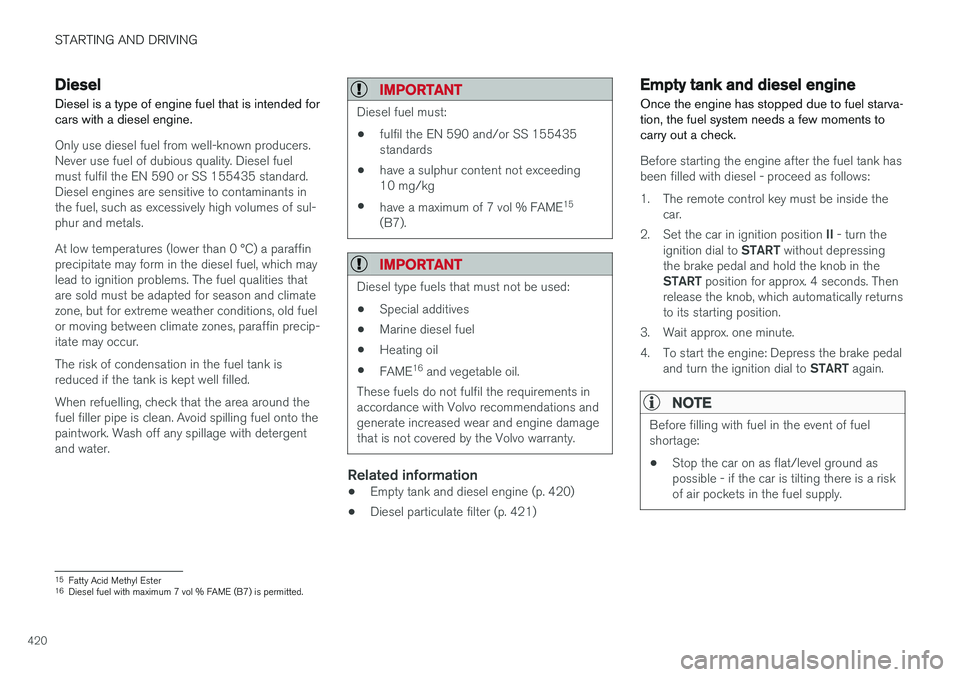
STARTING AND DRIVING
420
Diesel Diesel is a type of engine fuel that is intended for cars with a diesel engine.
Only use diesel fuel from well-known producers. Never use fuel of dubious quality. Diesel fuelmust fulfil the EN 590 or SS 155435 standard.Diesel engines are sensitive to contaminants inthe fuel, such as excessively high volumes of sul-phur and metals. At low temperatures (lower than 0 °C) a paraffin precipitate may form in the diesel fuel, which maylead to ignition problems. The fuel qualities thatare sold must be adapted for season and climatezone, but for extreme weather conditions, old fuelor moving between climate zones, paraffin precip-itate may occur. The risk of condensation in the fuel tank is reduced if the tank is kept well filled. When refuelling, check that the area around the fuel filler pipe is clean. Avoid spilling fuel onto thepaintwork. Wash off any spillage with detergentand water.
IMPORTANT
Diesel fuel must: •fulfil the EN 590 and/or SS 155435 standards
• have a sulphur content not exceeding10 mg/kg
• have a maximum of 7 vol % FAME 15
(B7).
IMPORTANT
Diesel type fuels that must not be used:
• Special additives
• Marine diesel fuel
• Heating oil
• FAME 16
and vegetable oil.
These fuels do not fulfil the requirements in accordance with Volvo recommendations andgenerate increased wear and engine damagethat is not covered by the Volvo warranty.
Related information
• Empty tank and diesel engine (p. 420)
• Diesel particulate filter (p. 421)
Empty tank and diesel engine
Once the engine has stopped due to fuel starva- tion, the fuel system needs a few moments tocarry out a check.
Before starting the engine after the fuel tank has
been filled with diesel - proceed as follows:
1. The remote control key must be inside the car.
2. Set the car in ignition position II - turn the
ignition dial to START without depressing
the brake pedal and hold the knob in the START position for approx. 4 seconds. Then
release the knob, which automatically returns to its starting position.
3. Wait approx. one minute.
4. To start the engine: Depress the brake pedal and turn the ignition dial to START again.
NOTE
Before filling with fuel in the event of fuel shortage:
• Stop the car on as flat/level ground aspossible - if the car is tilting there is a riskof air pockets in the fuel supply.
15
Fatty Acid Methyl Ester
16 Diesel fuel with maximum 7 vol % FAME (B7) is permitted.
Page 423 of 594
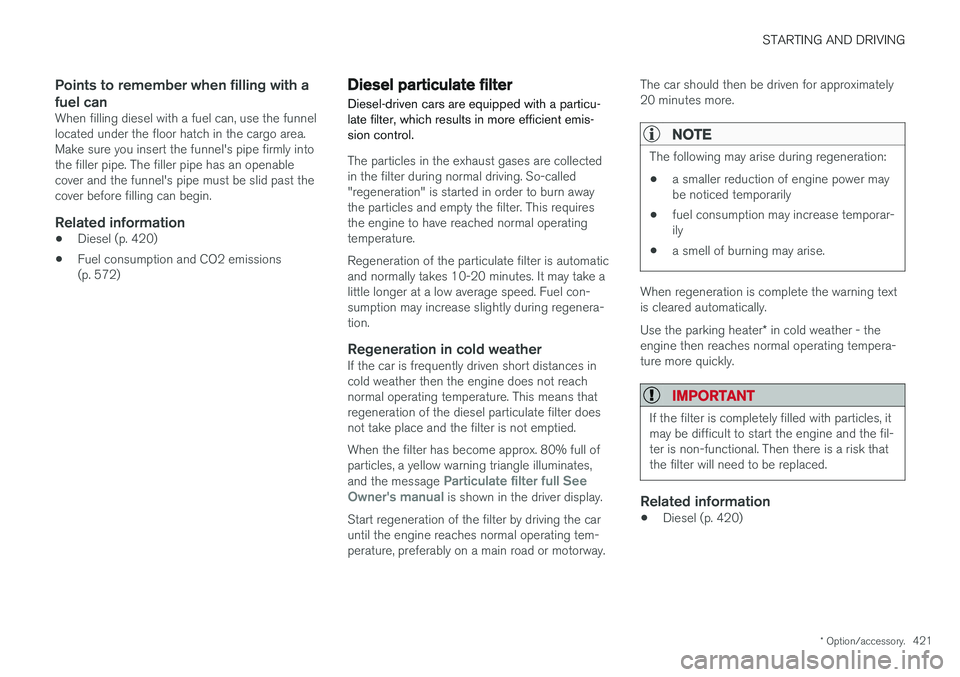
STARTING AND DRIVING
* Option/accessory.421
Points to remember when filling with a fuel can
When filling diesel with a fuel can, use the funnel located under the floor hatch in the cargo area.Make sure you insert the funnel's pipe firmly intothe filler pipe. The filler pipe has an openablecover and the funnel's pipe must be slid past thecover before filling can begin.
Related information
•Diesel (p. 420)
• Fuel consumption and CO2 emissions(p. 572)
Diesel particulate filter Diesel-driven cars are equipped with a particu- late filter, which results in more efficient emis-sion control.
The particles in the exhaust gases are collected in the filter during normal driving. So-called"regeneration" is started in order to burn awaythe particles and empty the filter. This requiresthe engine to have reached normal operatingtemperature. Regeneration of the particulate filter is automatic and normally takes 10-20 minutes. It may take alittle longer at a low average speed. Fuel con-sumption may increase slightly during regenera-tion.
Regeneration in cold weatherIf the car is frequently driven short distances incold weather then the engine does not reachnormal operating temperature. This means thatregeneration of the diesel particulate filter doesnot take place and the filter is not emptied. When the filter has become approx. 80% full of particles, a yellow warning triangle illuminates, and the message
Particulate filter full See
Owner's manual is shown in the driver display.
Start regeneration of the filter by driving the car until the engine reaches normal operating tem-perature, preferably on a main road or motorway. The car should then be driven for approximately20 minutes more.
NOTE
The following may arise during regeneration:
• a smaller reduction of engine power may be noticed temporarily
• fuel consumption may increase temporar-ily
• a smell of burning may arise.
When regeneration is complete the warning text is cleared automatically. Use the parking heater
* in cold weather - the
engine then reaches normal operating tempera- ture more quickly.
IMPORTANT
If the filter is completely filled with particles, it may be difficult to start the engine and the fil-ter is non-functional. Then there is a risk thatthe filter will need to be replaced.
Related information
• Diesel (p. 420)
Page 517 of 594
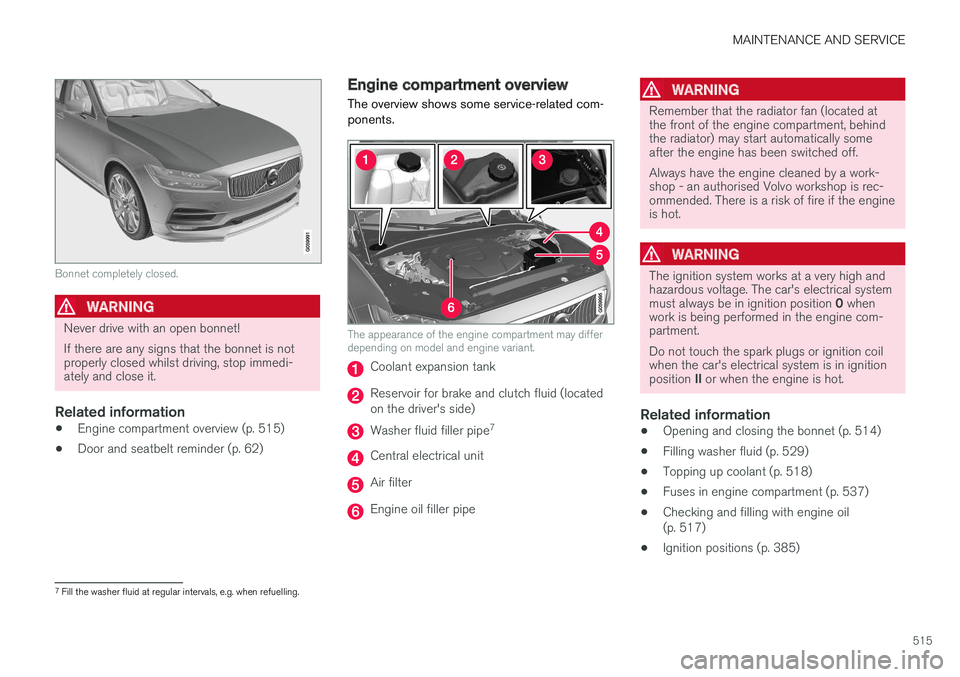
MAINTENANCE AND SERVICE
515
Bonnet completely closed.
WARNING
Never drive with an open bonnet! If there are any signs that the bonnet is not properly closed whilst driving, stop immedi-ately and close it.
Related information
•Engine compartment overview (p. 515)
• Door and seatbelt reminder (p. 62)
Engine compartment overview
The overview shows some service-related com- ponents.
The appearance of the engine compartment may differ depending on model and engine variant.
Coolant expansion tank
Reservoir for brake and clutch fluid (located on the driver's side)
Washer fluid filler pipe 7
Central electrical unit
Air filter
Engine oil filler pipe
WARNING
Remember that the radiator fan (located at the front of the engine compartment, behindthe radiator) may start automatically someafter the engine has been switched off. Always have the engine cleaned by a work- shop - an authorised Volvo workshop is rec-ommended. There is a risk of fire if the engineis hot.
WARNING
The ignition system works at a very high and hazardous voltage. The car's electrical system must always be in ignition position
0 when
work is being performed in the engine com- partment. Do not touch the spark plugs or ignition coil when the car's electrical system is in ignition position II or when the engine is hot.
Related information
• Opening and closing the bonnet (p. 514)
• Filling washer fluid (p. 529)
• Topping up coolant (p. 518)
• Fuses in engine compartment (p. 537)
• Checking and filling with engine oil (p. 517)
• Ignition positions (p. 385)
7
Fill the washer fluid at regular intervals, e.g. when refuelling.
Page 518 of 594
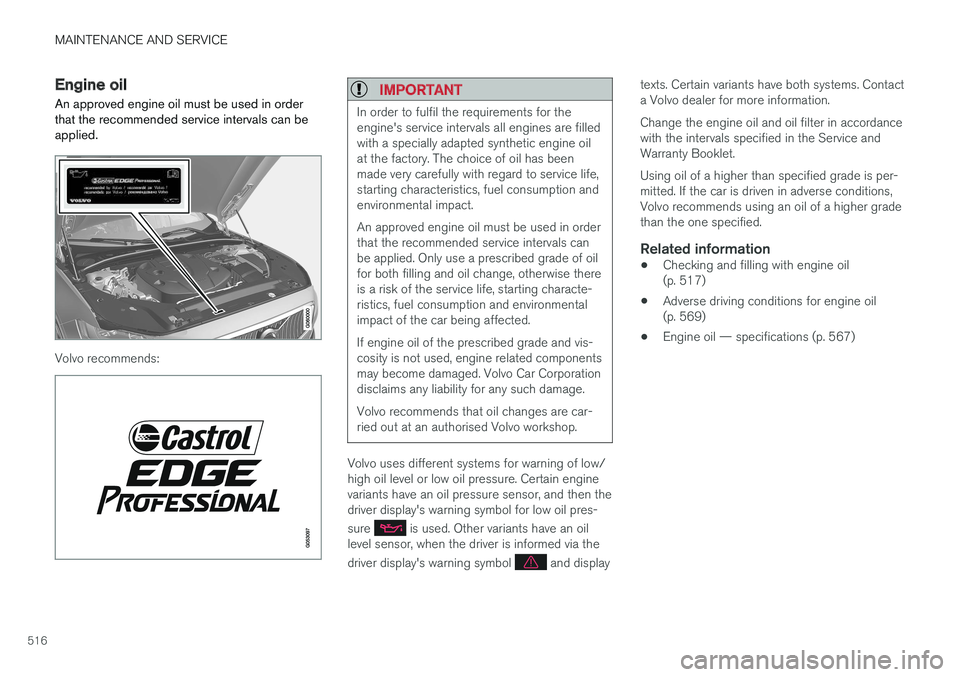
MAINTENANCE AND SERVICE
516
Engine oil
An approved engine oil must be used in order that the recommended service intervals can beapplied.
Volvo recommends:
IMPORTANT
In order to fulfil the requirements for the engine's service intervals all engines are filledwith a specially adapted synthetic engine oilat the factory. The choice of oil has beenmade very carefully with regard to service life,starting characteristics, fuel consumption andenvironmental impact. An approved engine oil must be used in order that the recommended service intervals canbe applied. Only use a prescribed grade of oilfor both filling and oil change, otherwise thereis a risk of the service life, starting characte-ristics, fuel consumption and environmentalimpact of the car being affected. If engine oil of the prescribed grade and vis- cosity is not used, engine related componentsmay become damaged. Volvo Car Corporationdisclaims any liability for any such damage. Volvo recommends that oil changes are car- ried out at an authorised Volvo workshop.
Volvo uses different systems for warning of low/ high oil level or low oil pressure. Certain enginevariants have an oil pressure sensor, and then thedriver display's warning symbol for low oil pres- sure
is used. Other variants have an oil
level sensor, when the driver is informed via the driver display's warning symbol
and display texts. Certain variants have both systems. Contact a Volvo dealer for more information. Change the engine oil and oil filter in accordance with the intervals specified in the Service andWarranty Booklet. Using oil of a higher than specified grade is per- mitted. If the car is driven in adverse conditions,Volvo recommends using an oil of a higher gradethan the one specified.
Related information
•
Checking and filling with engine oil(p. 517)
• Adverse driving conditions for engine oil(p. 569)
• Engine oil — specifications (p. 567)
Page 542 of 594

||
MAINTENANCE AND SERVICE
* Option/accessory.
540
Function
AA
Heated windscreen
* right-hand
side 40
Parking heater
* 20
Control unit for brake system (ABS pump) 40
- -
Heated windscreen
* right-hand
side Shunt
Supplied when the ignition is switched on: Engine controlmodule; Transmission compo-nents; Electric steering servo;Central electronic module; Con-trol module for brake system 5
- -
Right-hand headlamp 7.5 Right-hand headlamp, certain variants of LED
C 15
- -
- -
Module for controlling battery engagement 5
Function
AA
Airbags 5
Left-hand headlamp 7.5 Left-hand headlamp, certain variants of LED C 15
Accelerator pedal sensor 5
Transmission control module 15
Engine Control Module (ECM) 5
- -
- -
- -
- -
Engine control module; Actuator; Throttle unit; EGR valve (diesel);Position sensor for turbo (die-sel); Valve for turbocharger (pet-rol) 20
Solenoids (petrol); Valve; Ther- mostat for engine cooling sys-tem (petrol); EGR cooling pump(diesel); Glow control module(diesel)10
Function
AA
Vacuum regulators; Valve; Valve for output pulse (diesel) 7.5
Control module for spoiler roller cover; Control module for radia-tor roller cover; Relay coils foroutput pulse (diesel) 5
- -
Lambda-sond, front; Lambda- sond, rear (petrol)
15
Solenoid for engine oil pump; Solenoid clutch A/C; Lambdasond, centre (petrol); Lambdasond, rear (diesel)15
- -
Engine Control Module (ECM) 20
Ignition coils (petrol); Spark plugs (petrol)
15
Control module for vehicle gas
*B
15*B
Fuel filter heater (diesel) 30
- -
- -
- -
Page 569 of 594
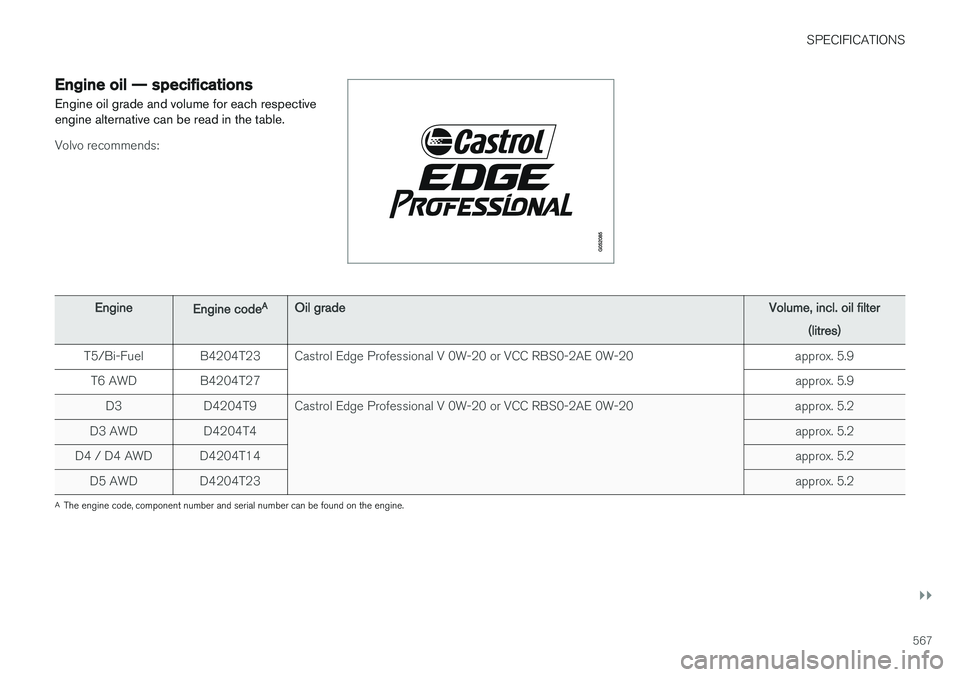
SPECIFICATIONS
}}
567
Engine oil — specifications Engine oil grade and volume for each respective engine alternative can be read in the table.
Volvo recommends:
EngineEngine codeA
Oil grade Volume, incl. oil filter
(litres)
T5/Bi-Fuel B4204T23 Castrol Edge Professional V 0W-20 or VCC RBS0-2AE 0W-20 approx. 5.9 T6 AWD B4204T27 approx. 5.9
D3 D4204T9 Castrol Edge Professional V 0W-20 or VCC RBS0-2AE 0W-20 approx. 5.2
D3 AWD D4204T4 approx. 5.2
D4 / D4 AWD D4204T14 approx. 5.2
D5 AWD D4204T23 approx. 5.2
A
The engine code, component number and serial number can be found on the engine.
Page 582 of 594
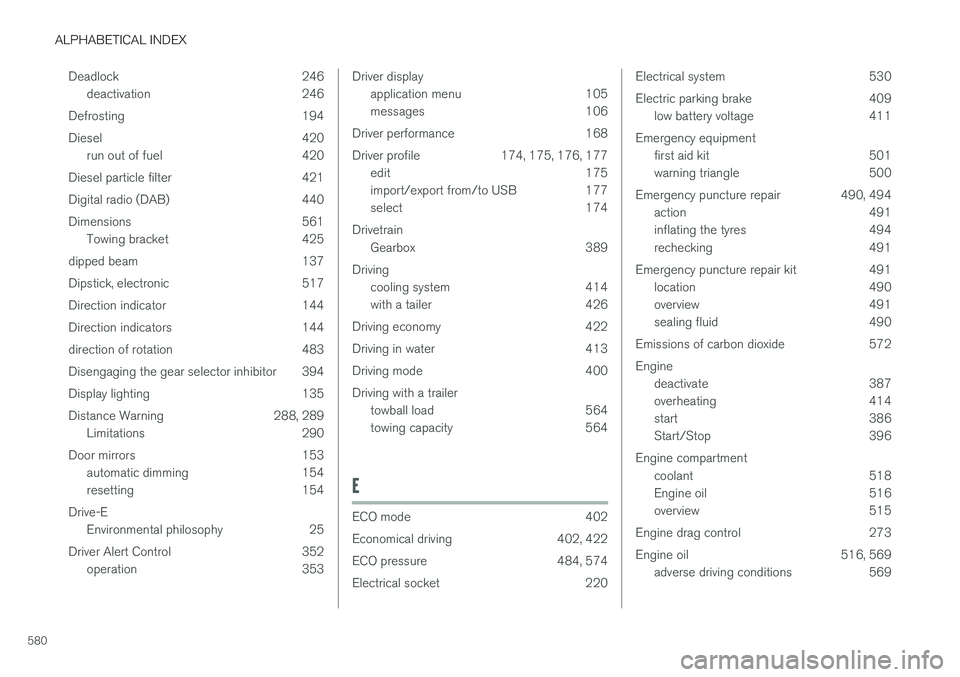
ALPHABETICAL INDEX
580Deadlock 246
deactivation 246
Defrosting 194
Diesel 420 run out of fuel 420
Diesel particle filter 421
Digital radio (DAB) 440
Dimensions 561 Towing bracket 425
dipped beam 137
Dipstick, electronic 517
Direction indicator 144
Direction indicators 144
direction of rotation 483
Disengaging the gear selector inhibitor 394
Display lighting 135
Distance Warning 288, 289 Limitations 290
Door mirrors 153 automatic dimming 154
resetting 154
Drive-E Environmental philosophy 25
Driver Alert Control 352 operation 353
Driver display
application menu 105
messages 106
Driver performance 168
Driver profile 174, 175, 176, 177 edit 175
import/export from/to USB 177
select 174
Drivetrain Gearbox 389
Driving cooling system 414
with a tailer 426
Driving economy 422
Driving in water 413
Driving mode 400Driving with a trailer towball load 564
towing capacity 564
E
ECO mode 402
Economical driving 402, 422
ECO pressure 484, 574
Electrical socket 220
Electrical system 530
Electric parking brake 409low battery voltage 411
Emergency equipment first aid kit 501
warning triangle 500
Emergency puncture repair 490, 494 action 491
inflating the tyres 494
rechecking 491
Emergency puncture repair kit 491 location 490
overview 491
sealing fluid 490
Emissions of carbon dioxide 572 Engine deactivate 387
overheating 414
start 386
Start/Stop 396
Engine compartment coolant 518
Engine oil 516
overview 515
Engine drag control 273
Engine oil 516, 569 adverse driving conditions 569
Page 583 of 594
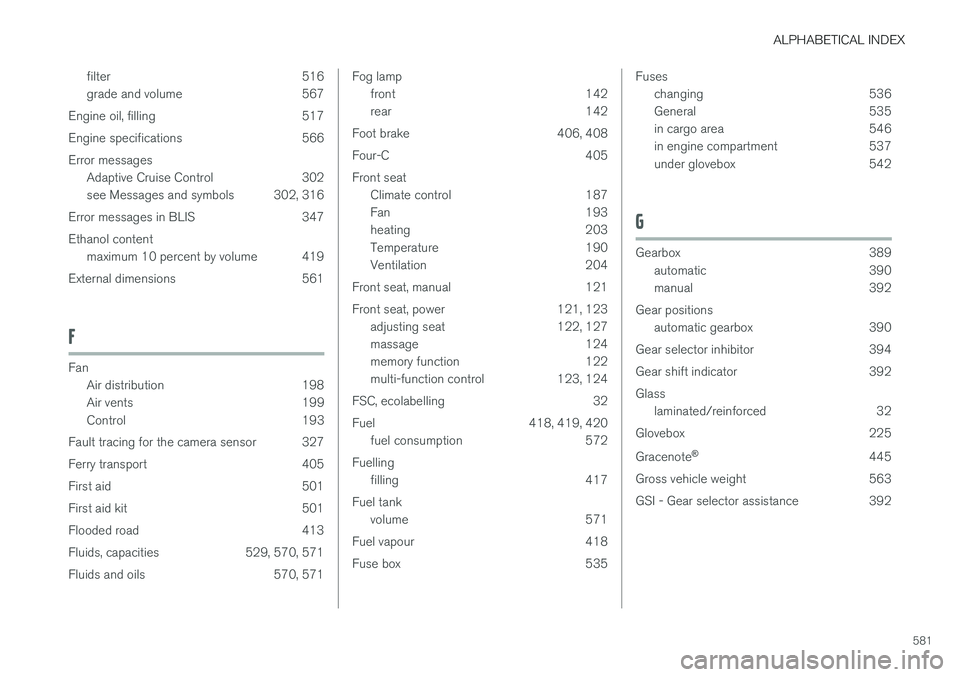
ALPHABETICAL INDEX
581
filter 516
grade and volume 567
Engine oil, filling 517
Engine specifications 566Error messages Adaptive Cruise Control 302
see Messages and symbols 302, 316
Error messages in BLIS 347 Ethanol content maximum 10 percent by volume 419
External dimensions 561
F
Fan Air distribution 198
Air vents 199
Control 193
Fault tracing for the camera sensor 327
Ferry transport 405
First aid 501
First aid kit 501
Flooded road 413
Fluids, capacities 529, 570, 571
Fluids and oils 570, 571
Fog lamp front 142
rear 142
Foot brake 406, 408
Four-C 405Front seat Climate control 187
Fan 193
heating 203
Temperature 190
Ventilation 204
Front seat, manual 121
Front seat, power 121, 123 adjusting seat 122, 127
massage 124
memory function 122
multi-function control 123, 124
FSC, ecolabelling 32
Fuel 418, 419, 420 fuel consumption 572
Fuelling filling 417
Fuel tank volume 571
Fuel vapour 418
Fuse box 535Fuses changing 536
General 535
in cargo area 546
in engine compartment 537
under glovebox 542
G
Gearbox 389automatic 390
manual 392
Gear positions automatic gearbox 390
Gear selector inhibitor 394
Gear shift indicator 392Glass laminated/reinforced 32
Glovebox 225 Gracenote ®
445
Gross vehicle weight 563
GSI - Gear selector assistance 392